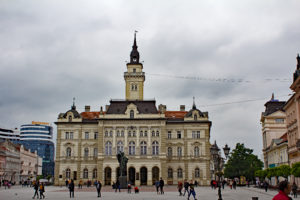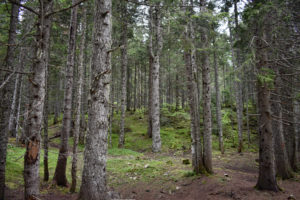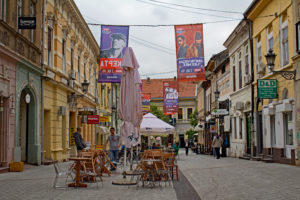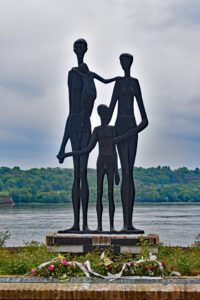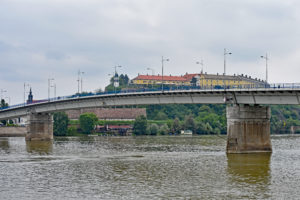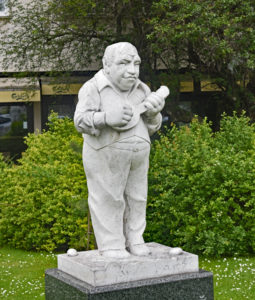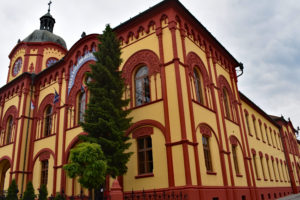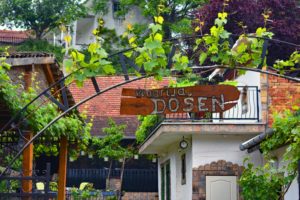Whilst staying in the Serbian capital Belgrade, we visited Novi Sad, the country’s second city which our Bradt guidebook said was ‘known for its history of scholarship and culture, this elegant city has been described as the Serbian Athens’. The town is currently the European Youth Capital and will be one of the European Capitals of Culture in 2021.
The bus, which took 90 minutes, dropped us at the long-distance bus station on the outskirts of town. Rather than trying to negotiate a city bus, we walked the 20 minutes into the town centre.
As we were passing the modern theatre, six tourist buses were disgorging passengers and attempting to avoid them, we quick marched to the large and open area, Trg Slobod (Trg means square). As in Belgrade, the architecture varied dramatically and on one corner was an old, ornate peach and cream coloured building complete with statue, and on the other, a modern orange monstrosity. The square was the home of the elegant City Hall and what was described as the Roman Catholic Cathedral, also known by the snappy title ‘Katedrala Rimokatolicka zupna crkva imena marijina’. However, it is not actually a cathedral, but a parish church dedicated to Mary. Inside the ‘not-a-cathedral, cathedral’, were a series of magnificent long stained-glass windows, all incorporating faces of modern people at the bottom: perhaps they were benefactors. The top of the high steeple and roof were covered with unusual multi-coloured tiles manufactured by the Hungarian factory, Zsolnay. In the middle of the square was a large statue of Svetozar Miletic, a famous politician, in striding, ranting pose.
In the café-lined Zmaj Jovina, we stopped for coffee at one of the many outdoor places and people watched. At the bottom of the street we found the Backa Bishop’s Palace (the home of Novi Sad’s Serbian orthodox Bishop), a building which incorporated many styles of architecture. Nearby was the Orthodox Cathedral Church of St. George where photographs were not allowed. Cafes and bars advertising a huge range of craft beers abounded and we could imagine how, what was a quiet street by day, would be transformed at night.
The pedestrianised street, Dunavaska, had attractive coloured buildings and small shops and at the bottom, a park which led us to the River Danube. The Varadin Bridge, which led across to the Petrovaradin Fortress, has a plaque reading ‘Varadinski Most – original one destroyed April 1, 1999 by NATO, killing citizen Novi Sad Oleg. M. Najov, aged 29’. During the NATO attacks, Novi Sad suffered more casualties than Belgrade in terms of human life, environmental pollution and destroyed infrastructure.
Unfortunately, we didn’t have time to explore the fortress but walked a short distance along the Danube to the Memorial of the Victims of the Massacre: a striking statue of a family which represented the 800 Jews and 700 Serbians killed by the Hungarians in 1942. We also saw remnants of concrete bridge supports in the river: all that is left of the Franz Josef Most Bridge again, destroyed by NATO and left as a permanent reminder.
Although there were a number of museums and galleries in Novi Sad, we were keen to see the nearby town of Sremski Karlovci, said to be one of the most attractive in Serbia. Having passed a statue of what our guidebook described as an Alfred Hitchcock lookalike, which in reality was a local musician, Janko Balaz, playing a tambourica, we found the bus stop for Sremski Karlovci.
10 minutes later we were in the small town with Christmas market style wooden booths in the central square, selling souvenirs and local products like honey which is a key part of the rural economy – the town also has a Zivanovic Family Museum of Bee-Keeping.
Whilst having a coffee and getting our bearings, we noticed several groups of children and depending on where they were, it was either exceptionally peaceful or incredibly noisy. It was easy to find our way around the main sights: the Patriarch Palace, Four Lions Fountain, St Nicholas Orthodox Cathedral, Catholic Parish Church and at the end of the street a brightly painted red and yellow building which was the high school and home to the town museum.
The town has several wine cellars and we found the Dosen Winery. After wandering through a small, but beautiful garden, we were greeted by a lady who led us into a room full of wine and offered tastings. We weren’t sure what the drill was, and the lady spoke little English, but we chose to taste two. We offered to buy a bottle of the chardonnay, but cards weren’t taken, and we had limited Dinar.
We caught the bus back to Belgrade late in the afternoon. This had not been the plan, but on asking about the rail connection we were informed that the train to and from Belgrade closed temporarily in Winter 2018 and is expected to take a couple of years to complete. Hopefully it will be open by 2021.
